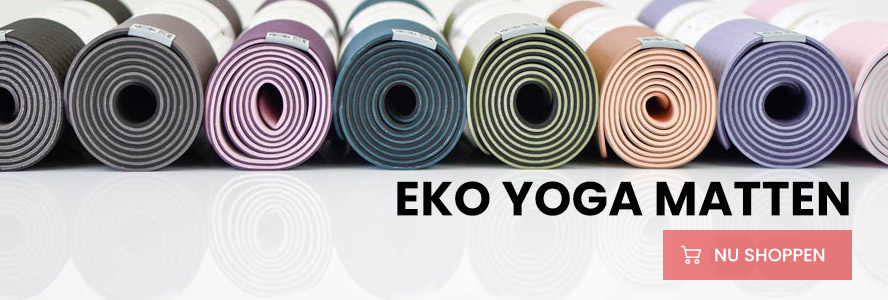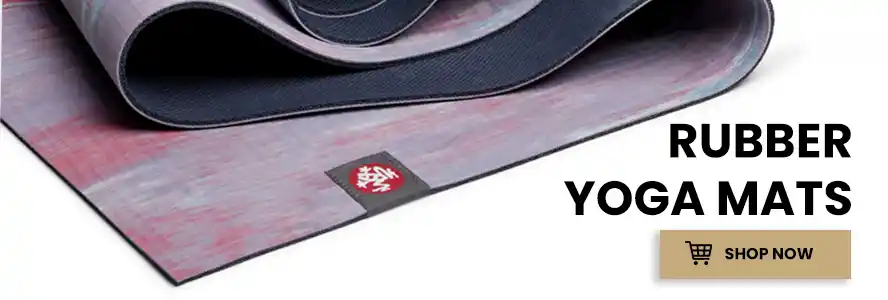The different yoga styles explained
Yoga is present in many different tastes and colors. And although yoga is in essence of course much more than just practicing yoga postures, this is usually the first thing that is meant when someone asks: which yoga style do you practice?
And then you have quite a few choices.....
The different yoga styles explained
For many people, the yoga path starts with learning and practicing the postures or asanas. The benefits of this are now widely known and everyone agrees that yoga can help you tremendously in finding a healthy balance between body and mind.
There is a huge range of yoga schools and online yoga classes. That is why it is quite difficult to see the forest for the trees. In any case, we often get the question "What kind of yoga suits me best?".
That is why we have listed the types for you.
Which yoga styles are there?
There are many different yoga styles nowadays. We list the most popular yoga styles and below we explain a number of yoga styles in detail:
- Hatha yoga
- Vinyasa yoga
- Slow flow yoga
- Bikram yoga
- Hot yoga
- Power yoga
- Yin yoga
- Yoga Nidra
- Ashtanga yoga
- Iyengar yoga
- Restorative yoga
- Kundalini Yoga
Below we explain the differences between yoga styles in detail.
Hatha Yoga
Hatha Yoga is one of the first yoga styles offered in the Netherlands. The first Hatha Yoga School in the Netherlands was founded in 1946. It is an open stream without a founder or gurus.
Ha-Tha stands for connection between sun (action) and the moon (internalisation) and the goal is to learn to control your body and your breathing. Work is mainly done from asana (physical exercises) and pranayama (control of breathing). In contrast to many other yoga styles, the teacher does not give any adjustments to the postures. The role of the teacher lies more in giving direction and energy, and the encouragement to make things happen and to be a spectator.
The yoga postures are held longer in this yoga style than in most 'dynamic' forms, and it is therefore a relatively 'quiet' style.
- Read more about Hatha Yoga in our blog What is Hatha Yoga? -
Yin Yoga & Restorative Yoga
A relatively new yoga style offered at yoga schools is Yin Yoga. Yin Yoga has been developed as a counterpart to the active 'yang' yoga forms such as Ashtanga, Vinyasa and Power Yoga.
Postures are held for a long time (5 to 10 minutes) in as complete a relaxation as possible. Because of this they do not work on your muscles but on your joints and the connective tissue. The style is partly based on the traditional Chinese meridian system that is also used in acupuncture. The goal is to stimulate energy pathways in these tissues, to promote blood flow and to create more flexibility.
Yin Yoga is very calm and meditative. Because the postures are held for so long, there is a lot of time and space to perceive what happens in your body and to find a kind of comfort in this by letting go of a deeper layer, both physically and mentally. The most important (but not the only) founders of Yin Yoga are Paul Grilley and Sarah Powers. The yoga style is very accessible to everyone.
Related to Yin Yoga and strongly emerging is currently Restorative Yoga. This yoga style is primarily focused on healing and restoring both mind and body through simple yoga postures that are often held for up to 20 minutes.
Many yoga props are used here, such as cushions, bolsters and belts. It is similar to Yin Yoga, but in this yoga style there is less emphasis on flexibility and more on deep relaxation and recovery.
The eco yoga mats are perfect for calm forms of yoga. They have an open cell structure with remarkably good grip. But more importantly, they are also softer than PVC, which provides greater comfort in sitting and lying positions.
Ashtanga Yoga, Power Yoga & Vinyasa Flow
Characteristic of Ashtanga Yoga is the dynamic performance of a fixed series of postures. These postures are fluidly connected by a combination of breath and movement (vinyasas). Because there are no breaks between the postures, a kind of 'flow' arises. The most famous series of postures is 'the Primary Series'.
Another important part of Astanga Yoga is the use of a special breathing technique, the Ujjayi breathing. This technique helps to intensify the energy flows in the body and create more heat, so you perspire and drain excess toxins. The characteristic soft rustling throat sound of Ujjayi breathing is also a focal point. Eventually breath and movement merge and this promotes a calm, meditative state.
The founder of Ashtanga Yoga is Sri K. Pattabhi Jois, who in turn taught this series by his master Krishnamacharya. Ashtanga refers to 'eight limbs' referring to the eight limbs of yoga described by the ancient Indian sage Patanjali in the 'Yoga Sutras'. Asana (body postures) and Pranayama (breathing exercises) are two of them.
Usually Ashtanga Yoga is given as an "led class", that is to say that the teacher orally guides the group and thus indicates the rhythm of the breaths and movements. Originally however, Ashtanga Yoga was passed on one by one from a teacher to a pupil and the pupil independently practiced the postures (ie without oral guidance and at his own pace) under the guidance of the teacher who regularly gave personal instructions and adjustments. In this way Asthanga Yoga can still be practiced, but then under the name 'Mysore Style'.
Under the name Power Yoga is usually meant an abbreviated lesson in Ashtanga Yoga. Out of respect only a whole series of Ashtanga postures is called 'Ashtanga', and as soon as you shorten this series by omitting some postures (for example to let the performance fit in a lesson of one hour, or make it more accessible for beginners). ) this yoga style is called Poweryoga instead of Ashtanga.
- Read more about Power Yoga in our blog Power Yoga: Is this the yoga style for you? -
Vinyasa Flow yoga is strongly inspired by Ashtanga and Poweryoga as a yoga style. As with those two dynamic forms, the teacher guides you from one pose to the next without stopping in between to discuss the subtleties of each posture.
The difference, however, is that Vinyasa releases the fixed series and track orders of attitudes and with new creativity new combinations and sequences of attitudes arise. For example, sessions are inspired by the evening and the morning, on the rhythm of certain music, on the sun and the moon, and even on the movements you make while surfing. One of the leading teachers in this yoga style is Shiva Rea.
- Read more about Vinyasa Yoga in our blog What is Vinyasa Yoga? We will tell you everything about it! -
The natural rubber mats are perfect for active yoga styles. They remain non-slip, even with perspiration and are wear-resistant.
Iyengar Yoga
B.K.S. Iyengar was, like Sri K. Pattabhi Jois, a student of Krishnamacharya. As a child, Iyengar had serious health problems that taught him to teach his yoga in a different way than his fellow students, and from that basis Iyengar further developed and perfected his style of yoga.
Precision, concentration and alignment are very important in Iyengar yoga, and the style strongly appeals to the self-healing ability of the body. We strive for the most precise execution of every posture to achieve perfect alignment and thus bring the body back into balance with the mind.
At Iyengar, the postures are actively maintained for a longer period of time, which can sometimes be quite challenging. In addition, relatively much use is made of yoga props: blocks, chairs and straps (yogabelts) are standard in every Iyengar studio.
Hot Yoga & Bikram Yoga
Hot Yoga and Bikram Yoga are practiced in a studio that is heated to a minimum of 40 degrees to simulate the climate in India as much as possible. A lesson lasts about one and a half hours, in which usually twice the same fixed series of 26 yoga postures are performed dynamically.
It is a very intensive and dynamic style, in which you will sweat a lot and remove a lot of waste. The heat in the room in combination with the intensity of the exercises makes this form pretty challenging and therefore will not be suitable for everyone. People with high blood pressure or heart problems can not try this type of yoga for example.
The founder of Bikram Yoga is Bikram Chaudhuri who has patented this yoga style. If a lesson does not fully comply with the certification and guidelines of Bikram, it can not be called a Bikram either (there is a lot of controversy about this). Hot Yoga is a collective name for all other intensive and dynamic yoga classes given in a room heated to at least 35 degrees.
Jivamukti Yoga
Jivamukti Yoga is a young yoga style developed in 1984 by Sharon Gannon and David Life in New York. Their style is based on dynamic yoga styles such as Ashtanga Yoga and is characterized by intensity (both physical and spiritual).
In addition to the practice of yoga postures in dynamic flow, during a Jivamukti class there is always attention for five central principles: Shastra (the old writings), Bhakti (devotion), Ahimsa (nonviolence, non-injuries), Nada (music) and Dhyana (meditation).
Yoga Nidra
Yoga Nidra means "yoga sleep" and is the most restful yoga style in the list: it is an exercise in as deep as possible relaxation while maintaining full consciousness. The practice of Yoga Nidra is done laying down, through a guided bodyscan technique with subsequent guided visualizations.
Yoga Nidra helps reduce tension and anxiety and relieve associated symptoms such as headaches, dizziness, chest pain, palpitations, sweating and abdominal pain. It is even used for war veterans in the treatment of post traumatic stress disorder (PTSD).
Kundalini Yoga
Kundalini Yoga is a yoga style designed to generate energy in the spine. Kundalini Yoga classes include meditation, breathing techniques such as alternative nostril breathing, and singing, as well as yoga postures. The exercises are mainly repetitive and therefore meditative.
- Read more about Kundalini Yoga in our blog What is Kundalini Yoga? Let us tell you all about Kundalini Yoga! -
A thick, comfortable mat is suitable for yoga where you sit and lie down a lot. This also means you cool down less quickly.
Other Yogastyles
This list is by no means complete. There are many more beautiful and interesting yoga styles to describe including Kriya Yoga (read also the book "Autobiography of a Yogi" by Yogananda!), Dru Yoga, Kripalu Yoga, Satyananda Yoga and then there are not many mentioned.
Nevertheless, we think the above list already gives a good overall impression with what is "for sale" when you look for the appropriate yoga style.
Have you already found the type of yoga that suits you best? Then a logical next step is to choose a good yoga mat.
Have fun in your journey of discovery and if we can help you with anything, please send us a message!













